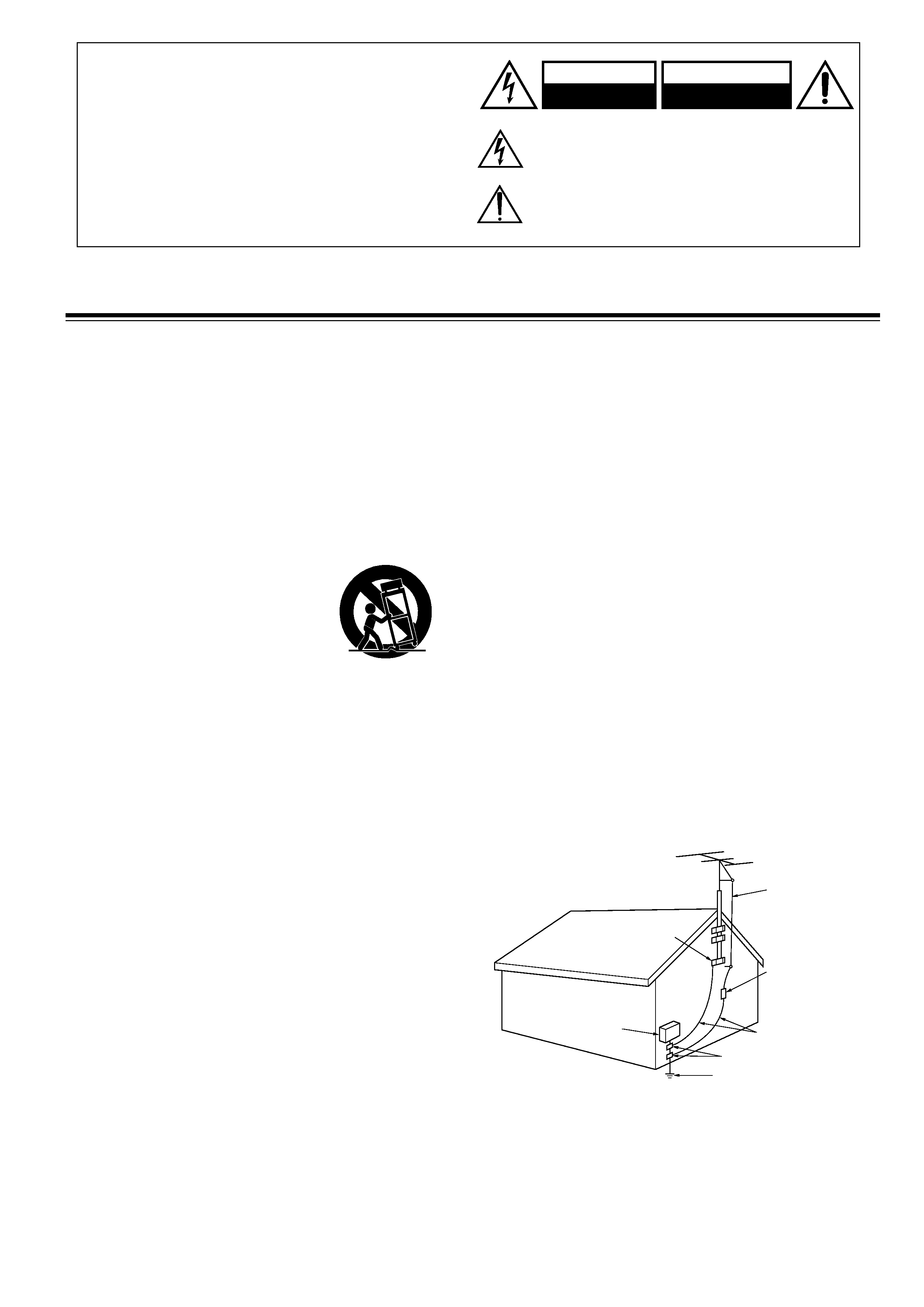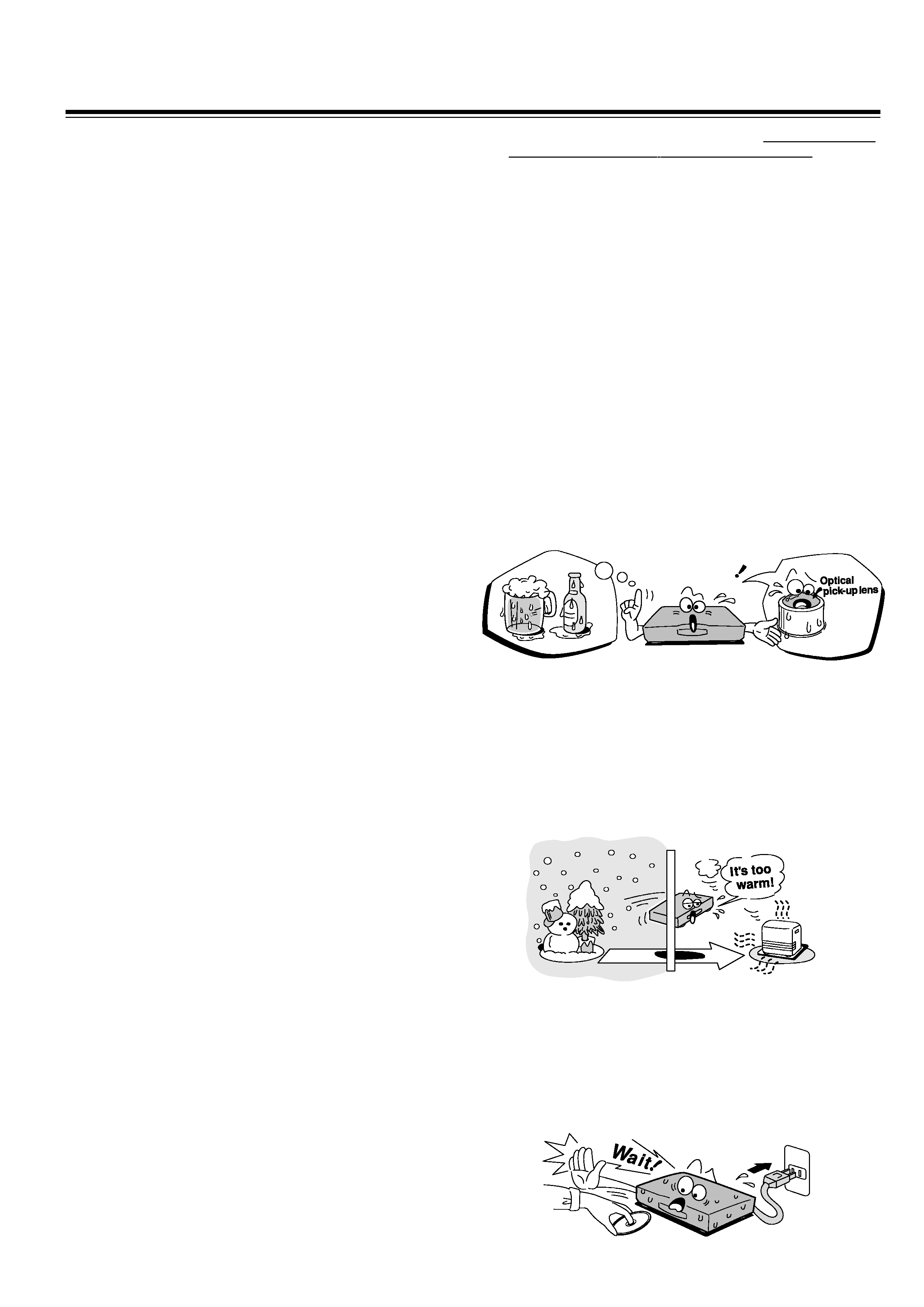
DVD Receiver
DR-90
Instruction Manual
Thank you for purchasing the ONKYO DVD Receiver.
Please read this manual thoroughly before making
connections and turning on the power.
Following the instructions in this manual will enable
you to obtain optimum performance and listening
enjoyment from your new DVD Receiver.
Please retain this manual for future reference.
Contents
6
20
33
58
61
Getting Started
Basic Operation
Advanced DVD/
VIDEO CD/
Audio CD
Operation
Additional Operation
Others
Before Using Your DVD Receiver
2
THIS DVD PLAYER IS MANUFACTURED FOR PLAYBACK
OF REGION 1 (USA, CANADA) ENCODED DV D
SOFTWARE. USE OF SOFTWARE NOT INTENDED FOR
REGION 1 PLAYBACK MAY RESULT IN UNDESIRABLE
PLAYER PERFORMANCE.

2
1.
Read Instructions - All the safety and operating instructions should
be read before the appliance is operated.
2.
Retain Instructions - The safety and operating instructions should
be retained for future reference.
3.
Heed Warnings - All warnings on the appliance and in the operating
instructions should be adhered to.
4.
Follow Instructions - All operating and use instructions should be
followed.
5.
Water and Moisture - The appliance should not be used near water
- for example, near a bathtub, washbowl, kitchen sink, laundry tub, in
a wet basement, or near a swimming pool, and the like.
6.
Carts and Stands - The appliance should be used only with a cart or
stand that is recommended by the
manufacturer.
6A. An appliance and cart combination should
be moved with care . Quick stops,
excessive force, and uneven surfaces may
cause the appliance and cart combination
to overturn.
7.
Wall or Ceiling Mounting - The appliance should be mounted to a
wall or ceiling only as recommended by the manufacturer.
8.
Ventilation - The appliance should be situated so that its location or
position does not interfere with its proper ventilation. For example,
the appliance should not be situated on a bed, sofa, rug, or similar
surface that may block the ventilation openings; or if placed in a built-
in installation, such as a bookcase or cabinet that may impede the
flow of air through the ventilation openings, there should be free space
of at least 20 cm (8 in.) and an opening behind the appliance.
9.
Heat - The appliance should be situated away from heat sources
such as radiators, heat registers, stoves, or other appliances (including
amplifiers) that produce heat.
10. Power Sources - The appliance should be connected to a power
supply only of the type described in the operating instructions or as
marked on the appliance.
11. Polarization - If the appliance is provided with a polarized plug having
one blade wider than the other, please read the following information:
The polarization of the plug is a safety feature. The polarized plug will
only fit the outlet one way. If the plug does not fit fully into the outlet,
try reversing it. If there is still trouble, the user should seek the services
of a qualified electrician. Under no circumstances should the user
attempt to defeat the polarization of the plug.
12. Power-Cord Protection - Power-supply cords should be routed so
that they are not likely to be walked on or pinched by items placed
upon or against them, especially near plugs, convenience receptacles,
and the point where they exit from the appliance.
13. Cleaning - The appliance should be cleaned only as recommended
by the manufacturer.
14. Power Lines - An outdoor antenna should be located away from
power lines.
GROUND
CLAMP
ELECTRIC
SERVICE
EQUIPMENT
POWER SERVICE GROUNDING
ELECTRODE SYSTEM
(NEC ART 250, PART H)
GROUND CLAMPS
GROUNDING CONDUCTORS
(NEC SECTION 810-21)
ANTENNA
DISCHARGE UNIT
(NEC SECTION 810-20)
ANTENNA
LEAD IN
WIRE
NEC NATIONAL ELECTRICAL CODE
S2898A
15. Nonuse Periods - The power cord of the appliance should be
unplugged from the outlet when left unused for a long period of time.
16. Object and Liquid Entry - Care should be taken so that objects do
not fall and liquids are not spilled into the enclosure through openings.
17. Damage Requiring Service - The appliance should be serviced by
qualified service personnel when:
A. The power-supply cord or the plug has been damaged; or
B. Objects have fallen, or liquid has been spilled into the
appliance; or
C. The appliance has been exposed to rain; or
D. The appliance does not appear to operate normally or
exhibits a marked change in performance; or
E. The appliance has been dropped, or the enclosure damaged.
18. Servicing - The user should not attempt to service the appliance
beyond that described in the operating instructions. All other servicing
should be referred to qualified service personnel.
19. Outdoor Antenna Grounding - If an outside antenna is connected
to the receiver, be sure the antenna system is grounded so as to
provide some protection against voltage surges and built up static
charges. Article 810 of the National Electrical Code, ANSI/NFPA 70,
provides information with regard to proper grounding of the mast and
supporting structure, grounding of the lead-in wire to an antenna-
discharge unit, size of grounding conductors, location of antenna-
discharge unit, connection to grounding electrodes, and requirements
for the grounding electrode. See Figure 1.
FIGURE 1:
EXAMPLE OF ANTENNA GROUNDING AS PER NATIONAL
ELECTRICAL CODE
Important Safeguards
S3125A
PORTABLE CART WARNING
WARNING:
TO REDUCE THE RISK OF FIRE OR ELECTRIC SHOCK,
DO NOT EXPOSE THIS APPLIANCE TO RAIN OR
MOISTURE.
CAUTION:
TO REDUCE THE RISK OF ELECTRIC SHOCK, DO NOT
REMOVE COVER (OR BACK). NO USER-SERVICEABLE
PARTS INSIDE. REFER SERVICING TO QUALIFIED
SERVICE PERSONNEL.
The lightning flash with arrowhead symbol, within an equilateral
triangle, is intended to alert the user to the presence of uninsulated
"dangerous voltage" within the product's enclosure that may be of
sufficient magnitude to constitute a risk of electric shock to persons.
The exclamation point within an equilateral triangle is intended to alert
the user to the presence of important operating and maintenance
(servicing) instructions in the literature accompanying the appliance.
WARNING
RISK OF ELECTRIC SHOCK
DO NOT OPEN
RISQUE DE CHOC ELECTRIQUE
NE PAS OUVRIR
AVIS

3
This unit contains a semiconductor laser system and is classified
as a "CLASS 1 LASER PRODUCT." So, to use this model properly,
read this Instruction Manual carefully. In case of any trouble, please
contact the store where you purchased the unit. To prevent being
exposed to the laser beam, do not try to open the enclosure.
DANGER:
INVISIBLE LASER RADIATION WHEN OPEN AND
INTERLOCK FAILED OR DEFEATED. AVOID DIRECT
EXPOSURE TO BEAM.
CAUTION:
THIS PRODUCT UTILIZES A LASER. USE OF CONTROLS
OR ADJUSTMENTS OR PERFORMANCE OF
PROCEDURES OTHER THAN THOSE SPECIFIED
HEREIN MAY RESULT IN HAZARDOUS RADIATION
EXPOSURE.
"CLASS 1 LASER
PRODUCT "
1. This unit is a CLASS 1 LASER PRODUCT and employs a laser
inside the cabinet.
2. To prevent the laser from being exposed, do not remove the
cover. Refer servicing to qualified personnel.
Precautions
For U.S. model
The laser is covered by a housing which prevents exposure during
operation or maintenance. However, this product is classified as a
Laser Product by CDRH (Center for Devices and Radiological Health)
which is a department of the Food and Drug Administration.
According to their regulations 21 CFR section 1002.30, all
manufactures who sell Laser Products must maintain records of
written communications between the manufacturer, dealers and
customers concerning radiation safety. If you have any complaints
about instructions or explanations affecting the use of this product,
please feel free to write to the address on the back page of this
manual. When you write us, please include the model number and
serial number of your unit.
In compliance with Federal Regulations, the certification, identification
and the period of manufacture are indicated on the rear panel.
FCC INFORMATION FOR USER
CAUTION:
The user changes or modifications not expressly approved by the
party responsible for compliance could void the user's authority to
operate the equipment.
NOTE:
This equipment has been tested and found to comply with the limits
for a Class B digital device, pursuant to Part 15 of the FCC Rules.
These limits are designed to provide reasonable protection against
harmful interference in a residential installation. This equipment
generates, uses and can radiate radio frequency energy and, if not
installed and used in accordance with the instructions, may cause
harmful interference to radio communications. However, there is no
guarantee that interference will not occur in a particular installation. If
this equipment does cause harmful interference to radio or television
reception, which can be determined by turning the equipment off and
on, the user is encouraged to try to correct the interference by one or
more of the following measures:
· Reorient or relocate the receiving antenna.
· Increase the separation between the equipment and receiver.
· Connect the equipment into an outlet on a circuit different from that
to which the receiver is connected.
· Consult the dealer or an experienced radio/TV technician for help.
Note to CATV system installer:
This reminder is provided to call the CATV system installer's attention
to Article 820-40 of the NEC, ANSI/NFPA 70, which provides
guidelines for proper grounding and, in particular, specifies that the
cable ground shall be connected to the grounding system of the
building, as close to the point of cable entry as practical.
For Canadian model
CAUTION: THIS DIGITAL APPARATUS DOES NOT EXCEED THE
CLASS B LIMITS FOR RADIO NOISE EMISSION FROM DIGITAL
APPARATUS SET OUT IN THE RADIO INTERFERENCE
REGULATIONS OF THE CANADIAN DEPARTMENT OF
COMMUNICATIONS.
For models having a power cord with a polarized plug:
CAUTION: TO PREVENT ELECTRIC SHOCK, MATCH WIDE
BLADE OF PLUG TO WIDE SLOT, FULLY INSERT.
Modele pour les Canadien
ATTENTION: L'INTERFERENCE RADIO ELECTRIQUE GENEREE
PAR CET APPAREIL NUMERIQUE DE TYPE B NE DEPASSE PAS
LES LIMITES ENONCEES DANS LE REGLEMENT SUR LES
PERTURBATIONS RADIO ELECTRIQUES, SECTION APPAREIL
NUMERIQUE, DU MINISTERE DES COMMUNICATIONS.
Sur les modeles dont la fiche est polarisee:
ATTENTION: POUR EVITER LES CHOCS ELECTRIQUES,
INTRODUIRE LA LAME LA PLUS LARGE DE LA FICHE DANS LA
BORNE CORRESPONDANTE DE LA PRISE ET POUSSER
JUSQU'AU FOND.

4
1. Warranty Claim
You can find the serial number on the rear panel of this unit. In case
of warranty claim, please report this number.
2. Recording Copyright
Recording of copyrighted material for other than personal use is illegal
without permission of the copyright holder.
3. AC Fuse
The fuse is located inside the chassis and is not user-serviceable. If
power does not come on, contact your Onkyo authorized service
center.
4. Power
WARNING
BEFORE PLUGGING IN THE UNIT FOR THE FIRST TIME, READ
THE FOLLOWING SECTION CAREFULLY.
The voltage of the available power supply differs according to country
or region. Be sure that the power supply voltage of the area where
this unit will be used meets the required voltage (e.g., AC 230 V, 50
Hz or AC 120 V, 60 Hz) written on the rear panel.
Worldwide models are equipped with a voltage selector to conform
to local power supplies. Be sure to set this switch to match the voltage
of the power supply in your area before plugging in the unit.
5. Do not touch this unit with wet hands
Do not handle this unit or power cord when your hands are wet or
damp. If water or any other liquid enters the case, take this unit to an
authorized service center for inspection.
6. Location of this unit
· Place this unit in a well-ventilated location.
Take special care to provide plenty of ventilation on all sides of this
unit especially when it is placed in an audio rack. If ventilation is
blocked, this unit may overheat and malfunction.
· Do not expose this unit to direct sunlight or heating units as this
unit's internal temperature may rise and shorten the life of the pickup.
· Avoid damp and dusty places and places directly affected by vibrations
from the speakers. In particular, avoid placing the unit on or above
one of the speakers.
· Be sure this unit is placed in a horizontal position. Never place it on
its side or on a slanted surface as it may malfunction.
· When you place this DVD Receiver near a TV, radio, or VCR, the
playback picture may become poor and the sound may be distorted.
In this case, place the DVD Receiver away from the TV, radio, or
VCR.
7. Care
From time to time you should wipe the front and rear panels and the
cabinet with a soft cloth. For heavier dirt, dampen a soft cloth in a
weak solution of mild detergent and water, wring it out dry, and wipe
off the dirt. Following this, dry immediately with a clean cloth.
Do not use rough material, thinners, alcohol or other chemical solvents
or cloths since these could damage the finish or remove the panel
lettering.
8. Notes on Handling
· When shipping the DVD Receiver, use the original shipping carton
and packing materials. For maximum protection, repack the unit as it
was originally packed at the factory.
· Do not use volatile liquids, such as insect spray, near the DVD
Receiver. Do not leave rubber or plastic products in contact with the
DVD Receiver for a long time. They will leave marks on the finish.
Precautions
· The top and rear panels of the DVD Receiver may become warm
after a long period of use. This is not a malfunction.
· When the DVD Receiver is not in use, be sure to remove the disc
and turn off the power.
· If you do not use the DVD Receiver for a long period, the unit may
not function properly in the future. Turn on and use the DVD Receiver
occasionally.
9. To Obtain a Clear Picture
The DVD Receiver is a high technology, precision device. If the optical
pick-up lens and disc drive parts are dirty or worn down, the picture
quality becomes poor. To obtain a clear picture, we recommend
regular inspection and maintenance (cleaning or parts replacement)
every 1,000 hours of use depending on the operating environment.
For details, contact your nearest dealer.
10. Notes on Moisture Condensation
Moisture condensation damages the DVD Receiver.
Please read the following carefully.
Moisture condensation occurs, for example, when you pour a cold
drink into a glass on a warm day. Drops of water form on the outside
of the glass. In the same way, moisture may condense on the optical
pick-up lens inside this unit, one of the most crucial internal parts of
the DVD Receiver.
· Moisture condensation occurs in the following cases.
- When you bring the DVD Receiver directly from a cold place to a
warm place.
- When you use the DVD Receiver in a room where you just turned on
the heater, or a place where the cold wind from the air conditioner
directly hits the unit.
- In summer, when you use the DVD Receiver in a hot and humid
place just after you move the unit from an air conditioned room.
- When you use the DVD Receiver in a humid place.
· Do not use the DVD Receiver when moisture condensation may occur.
If you use the DVD Receiver in such a situation, it may damage discs
and internal parts. Remove the disc, connect the power cord of the
DVD Receiver to the wall outlet, turn on the DVD Receiver, and leave
it for two or three hours. After a few hours, the DVD Receiver will
have warmed up and evaporated any moisture. Keep the DVD
Receiver connected to the wall outlet and moisture condensation
will seldom occur.
Examples of moisture
condensation

5
Table of Contents
Important Safeguards/Precautions/Table of Contents ......................................................... 25
Getting Started
6
Features .................................................................................................................................. 6
Supplied Accessories .............................................................................................................. 7
Preparing the Remote Controller ............................................................................................ 8
Notes on Discs ........................................................................................................................ 9
Connecting to a TV ............................................................................................................... 10
Connecting to Audio/Video Equipment ................................................................................. 11
Connecting Speakers ............................................................................................................ 12
Positioning Speakers ............................................................................................................. 13
Making Antenna Connections ............................................................................................... 14
Connecting to AC OUTLET on the Rear Panel ..................................................................... 16
Connecting the Power/Turning on the DVD Receiver ............................................................ 17
Speaker Setup ...................................................................................................................... 18
Basic Operation
20
Playing DVD Videos/VIDEO CDs/Audio CDs ........................................................................ 20
Listening to the Radio ........................................................................................................... 26
Playing the Connected Source .............................................................................................. 28
Various Functions Common to all the Sources ..................................................................... 29
Enjoying the Sound Effects ................................................................................................... 30
Advanced DVD/VIDEO CD/Audio CD Operation
33
Playing Repeatedly ............................................................................................................... 33
Playing in a Favorite Order .................................................................................................... 34
Playing in Random Order ...................................................................................................... 35
Zooming a Picture ................................................................................................................. 36
Selecting the Camera Angle ................................................................................................. 37
Selecting Subtitles Included on the DVD ............................................................................... 38
Selecting Audio Language/Sound Included on the Disc ....................................................... 39
Changing the Sound Signal Conversion Method .................................................................. 40
Using the On-Screen Display ................................................................................................ 42
Customizing the Function Settings ....................................................................................... 44
Table of Languages ............................................................................................................... 57
Additional Operation
58
Recording Using the Connected Equipment ......................................................................... 58
Customizing the Remote Controller to Your TV ..................................................................... 60
Others
61
Troubleshooting ..................................................................................................................... 61
Specifications ........................................................................................................................ 63
Index to Parts and Controls ................................................................................................... 64
